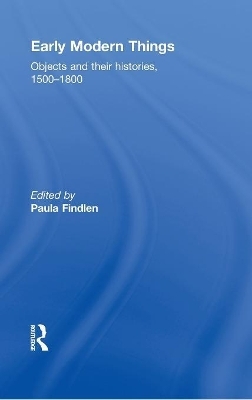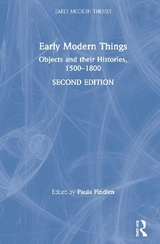
Objects and their Histories, 1500-1800
Routledge (Verlag)
978-0-415-52050-8 (ISBN)
- Titel erscheint in neuer Auflage
- Artikel merken
Divided into six parts this book explores; the ambiguity of things, representing things, making things, empires of things, consuming things and lastly the power of things. Spanning across the early modern world, from Ming dynasty China to Georgian England, and from Ottoman Egypt to Spanish America, the authors provide a generous set of examples in how to study the circulation, use, consumption and, most fundamentally, the nature of things themselves.
Drawing on a broad range of disciplinary perspectives and lavishly illustrated, Early Modern Things supplies fresh and provocative insights into how objects – ordinary and extraordinary, secular and sacred, natural and man-made – came to define some of the key developments of the early modern world. This book will be essential reading for all those interested in the early modern world.
Paula Findlen is Ubaldo Pierrotti Professor of Italian History and Co-Director of the Center for Medieval and Early Modern Studies at Stanford University, USA. Her previous works include Possessing Nature: Museums, Collecting and Scientific Culture in Early Modern Italy, which was awarded the Pfizer Prize in the History of Science, and (co-edited with Pamela Smith) Merchants and Marvels: Commerce, Science and Art in Early Modern Europe.
Introduction Early Modern Things: Setting Objects in Motion, 1500-1800 Paula Findlen Part One: The Ambiguity of Things
Chapter One: Surface Tension: Objectifying Ginseng in Chinese Early Modernity Carla Nappi Chapter Two: Going to the Birds: Animals as Things and Beings in Early Modernity Marcy Norton Chapter Three: The Restless Clock Jessica Riskin Part Two: Representing Things Chapter Four: "Stil-staende dingen": Picturing Objects in the Dutch Golden Age Julie Hochstrasser Chapter Five: "Things Seen and Unseen": The Material Culture of Early Modern Inventories and Their Representation of Domestic Interiors Giorgio Riello Chapter Six: Costume and Character in the Ottoman Empire: Dress as Social Agent in Nicolay’s Navigations Chandra Mukerji Part Three: Making Things Chapter Seven: Making Things: Techniques and Books in Early Modern Europe Pamela H. Smith Chapter Eight: Capricious Demands: Artisanal Goods, Business Strategies, and Consumer Behavior in Seventeenth-Century Florence Corey Tazzara Part Four: Empires of Things Chapter Nine: Locating Rhubarb: Early Modern Russia’s Relevant Obscurity Erika Monahan Chapter Ten: The World in a Shilling: Silver Coins and the Challenge of Political Economy in the Early Modern Atlantic World Mark A. Peterson Chapter Eleven: Anatolian Timber and Egyptian Grain: Things That Made the Ottoman Empire Alan Mikhail Part Five: Consuming Things Chapter Twelve: The Tokugawa Storehouse: Ieyasu’s Encounters with Things Morgan Pitelka Chapter Thirteen: Porcelain for the Poor: The Material Culture of Tea and Coffee Consumption in Eighteenth-Century Amsterdam Anne E.C. McCants Chapter Fourteen: Fashioning Difference in Georgian England: Furniture For Himand For Her Amanda Vickery Epilogue: The Power of Things Denaturalizing Things: A Comment Renata Ago Something New: A Comment Timothy Brook Identities through Things: A Comment Erin K. Lichtenstein
| Erscheint lt. Verlag | 11.12.2012 |
|---|---|
| Reihe/Serie | Early Modern Themes |
| Zusatzinfo | 72 Halftones, black and white |
| Verlagsort | London |
| Sprache | englisch |
| Maße | 156 x 234 mm |
| Gewicht | 816 g |
| Themenwelt | Geschichte ► Allgemeine Geschichte ► Neuzeit (bis 1918) |
| Sozialwissenschaften | |
| ISBN-10 | 0-415-52050-9 / 0415520509 |
| ISBN-13 | 978-0-415-52050-8 / 9780415520508 |
| Zustand | Neuware |
| Haben Sie eine Frage zum Produkt? |
aus dem Bereich



